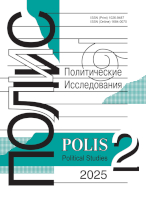Getting over Eurasia (geo-economic essay)
Neklessa A.I.,
Chairman of the Commission on the social and cultural globalization; member of the Bureau of the Scientific Council “History of World Culture” at the Presidium of the Russian Academy of Sciences (RAS); Head of the Laboratory for Geo-economic Analysis, Institute for African Studies of the Russian Academy of Sciences, neklessa@intelros.ru
elibrary_id: 74629 |
DOI: 10.17976/jpps/2014.03.03
Neklessa A.I. Getting over Eurasia (geo-economic essay). – Polis. Political Studies. 2014. No. 3. https://doi.org/10.17976/jpps/2014.03.03
The current era is a time of global transformation of the world order: the transit of territorial (geopolitical) format of Modernity urban culture and its main political form, the national state to geo-economic state: a dynamic modus operandi trans-boundary metapolis culture (geo-economics). Actual formula of current peace-building phase is a new regionalism, which is formed on the basis of existing economic ties within the geo-economic matrix of the new division of labor and socio-cultural gravity connecting complementary peoples in complex dynamic community, based on anthropological rather than territorial reading of post-modern political geography (“country is its people”). Key resource is the socio-cultural identity and active, productive viability manifested within the geo-economic and post-economic worldview. Folding the Russian identity is closely linked to territorial expansion in the north-east direction, which embraced both colonization and geo-cultural build vast expanses and targeted promotions to the ocean coast: wiring the Northern Sea Route, the laying of the Great Siberian tract, improvement of Maritime Province (Primorye) with access to the open spaces of the Pacific (Slavorossia – “Slavic Russia”), as well as the progressive development of Turkestan and Northeast China (“Yellow Russia”) with the prospect of implementing the idea of Trans-Eurasian springboard. Primary means of expansion and improvement conceived transport arteries, mainly railway construction: Trans-Siberian, Chinese Eastern Railway, South Manchurian Railway, and other Trans-Caspian routes. Implementation of large-scale transport and infrastructure megaproject in Russian was completed at the beginning of the 20th century and was the basis for industrial, industrial takeoff.
See also:
Lukin A.V.,
Russia and China in Greater Eurasia. – Polis. Political Studies. 2020. No5
Karaganov S.A.,
Departure of Military Superiority of the West, and Geo-Economics. – Polis. Political Studies. 2019. No6
PANORAMA OF POLITICAL SCIENCE OF RUSSIA: FAR EAST. – Polis. Political Studies. 2004. No5
Simonia N.A.,
New strategic factors in the struggle for Russia’s modernization. – Polis. Political Studies. 2014. No3
Graham T.,
Russia and the United States on the world stage. Part I. From distant friendship to incipient rivalry. – Polis. Political Studies. 2022. No1





.jpg)






 print
print
.jpg)
.jpg)